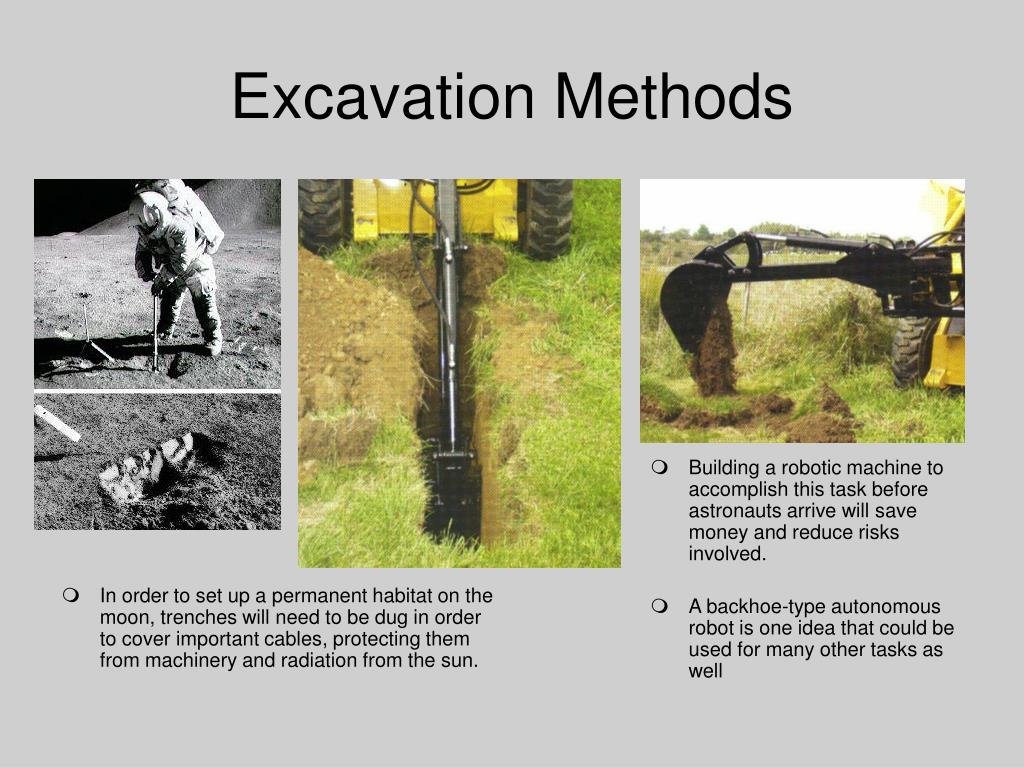Excitement About Excavation Contractors Near Me
Wiki Article
What Does Excavation Contractors Near Me Do?
Table of ContentsRumored Buzz on Grading ContractorsTrencher - An OverviewAn Unbiased View of Excavating ContractorsGet This Report on Grading ContractorsDemolition Things To Know Before You Get This


Scrapers or Pans dig deep into soil in one location, haul and discard the dirt in another area (excavation companies). It is hard to match the efficiency of scrapes for cut/fill soil operation if the haul range is much less then a mile. Scrapes are generally pulled by a rubber tire wheel tractor and also are often pressed via the cut location by an excavator.
There are lot of times that scrapers are not used for site grading as well as a dump truck is employed: the haul may be to long, the haul may cross roads where scrapers are not permitted, tough rock might be experienced, devices schedule, and so on. Dispose vehicles remain in common usage and also most likely need little discussion.
"Rock body" beds, on the other hand, have no tailgates and also can unload any type of size rock, although their quantity capacity is diminished. Compaction Tools enhances the thickness of the soil and in some cases provides a smooth, rolled surface.
Getting My General Contractor To Work
From a straightforward examination pit to percussion exploration to core exploration the proprietor has progressively a lot more costly alternatives that yield significantly better data about the site underground. For instance, the Proprietor on a 100,000 SF structure task might accredit twenty uninteresting places with split spoon soil samples taken up until rock is gotten to and after that core examples of rock.Understanding the type and high quality of rock (from the core examples) and location of rock (from the soils boring) is a real benefit in jobsite planning. Conversely, the Proprietor of a 100,000 SF building may decide to wage no geotechnical testing whatsoever. The choice regarding geotechnical testing is usually made by a Proprietor with no input from the Building Supervisor.
The area on Dirts and Geology helps you recognize the terms in the geotechnical record. An understanding of the approximate location of the rock assists the Building Manager to plan the series of steps adhering to rock excavation. If rock remains in one corner of a huge structure project, for instance, the earth excavation could start at the opposite end of the building in order to begin structure work soonest.
Beginning the foundation job early would be an excellent idea if the rock can be gotten rid of by tearing. Nonetheless, if the rock is exceptionally hard as well as needs significant blasting, it may be sensible to hold foundation work till the blasting is finished. The Construction Supervisor need to coordinate these types of choices and also utilize all the technical day offered.
Some Ideas on Demolition You Need To Know
Unclassified excavation states that all rock or various other unanticipated materials (excluding hazardous products) experienced in the sitework will certainly be the obligation of the Service provider at no change in agreement price. An unidentified excavation is easier from a book-keeping perspective and places the duty for geotechnical problems onto the Sitework Specialist.Just How Water Impacts Sitework? It's impressive what a hefty rainfall can do to a construction task. Before the rain, the site might be dry, hefty equipment efficiently moving earth, the other trades smoothly doing their job. Within hours the project can be a careless, mud-hole with employee performance reduced to regarding 10%.
In a lot of locations of the globe, the Construction Supervisor must remember a straightforward reality: IT WILL CERTAINLY RAIN. Great planning can reduce the damages and interruption of a hefty rain to a jobsite. Frequently the excavation as well as grading is delegated the Sitework Service Provider (and their Foremen is liable to supervise and also guide the heavy equipment and drivers).
The Building and construction Manager need to be constantly conscious of what rain will do to the job site. It is not uncommon for the Sitework Foreman to function their heavy you could check here devices for maximum efficiency and hope it doesn't rainfall. Among the finest methods to get ready for rainfall is to incline all grades to drain as well as to smooth rolled the surface area before a rainfall.
Rumored Buzz on Excavation Companies
The Building Manager must be discerning adequate to guarantee that heavy rain does not quit working on the task longer than necessary. Daily discussions with Sitework Foremen might be required to achieve this goal. At any time excavation is needed listed below the existing groundwater level on a project, the procedure of dewatering should be taken into consideration.In a really cohesive soil, the water travels so slowly with the clay or silt Resources that dewatering is not generally needed for the fairly short time of excavation. Dewatering may be needed for a single footing excavation or for a whole task site. The most typical dewatering methods are trench drains pipes, deep wells and also well points.

Ground water seepage can additionally be lowered by cutoff approaches such as sheet loading. The costs for dewatering can be astonishing, consisting of tools service, labor and also electrical energy (or gas). High dewatering costs have paled the revenue margins on far a lot of jobs. The numerous variables listed here make the job of approximating dewatering costs extremely difficult, and very inexact.
This alternative should constantly be thought about when analyzing the possibility this contact form of dewatering. Obviously the choice is only sensible if gravity can run the water to reduced ground. Trench drains pipes can be reduced with a backhoe as well as loaded with a crude, granular product (# 4 rock as an example), however care should be exercised in selecting the water electrical outlet type and also location.
The Greatest Guide To Trencher
A siphon, by interpretation, makes use of atmospheric stress to carry water from one elevation, up over a challenge, to a reduced altitude. The pipelines in a siphon system need to be impermeable and some resourcefulness is usually required to totally fill up the siphon pipe. The siphon pipe have to be complete for the siphon to begin.A deep well contains a pump, hose and also a vertical well casing. The pump intake is at the bottom of the well housing (normally some smashed stone is placed down there as a filter medium) (excavation companies). The water is inflated the hose pipe, out of the well casing, and to an ideal discharge place.
In a coarse sand, as an example, a big location can be pumped to near the pump consumption elevation. A less permeable dirt, on the other hand, decreases the effectiveness of a deep well. Because the pump is typically at the bottom of the deep well, there are no height limitations due to vacuum lift, as well as deep wells can reduce the groundwater over 50 feet.
On the base of the wellpoint there is a 2 foot long display and valve, water jets out of this valve as well as develops a hole into which the wellpoint pipeline can be decreased. This hole is frequently made a larger size (as an example 10 inches) to permit for a rugged sand backfill to help filter the water (general contractor).
Report this wiki page